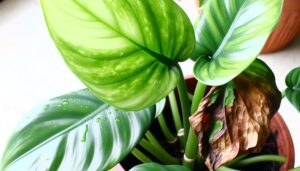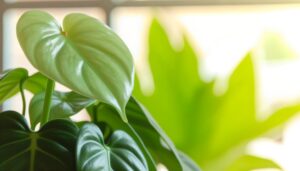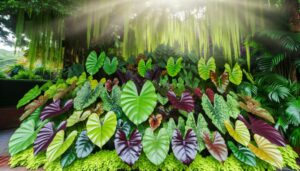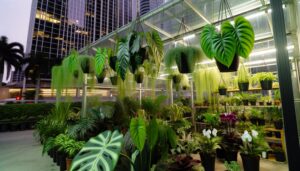What Is a Philodendron Brasil Totem?
The Philodendron Brasil Totem is a cultivated variety of Philodendron hederaceum, indigenous to Central and South American rainforests. This Araceae family member showcases heart-shaped, shiny leaves with vivid green and yellow variegation.
It demonstrates a climbing growth pattern, aided by aerial roots, making it suitable for moss poles or trellises. It flourishes in settings with moderate humidity, indirect sunlight, and well-draining yet moisture-retentive soil.
Regular pruning ensures peak aesthetics and structural integrity. With proper care, this plant can elevate any indoor space.
Keep delving into the specifics of its cultivation requirements and potential issues.
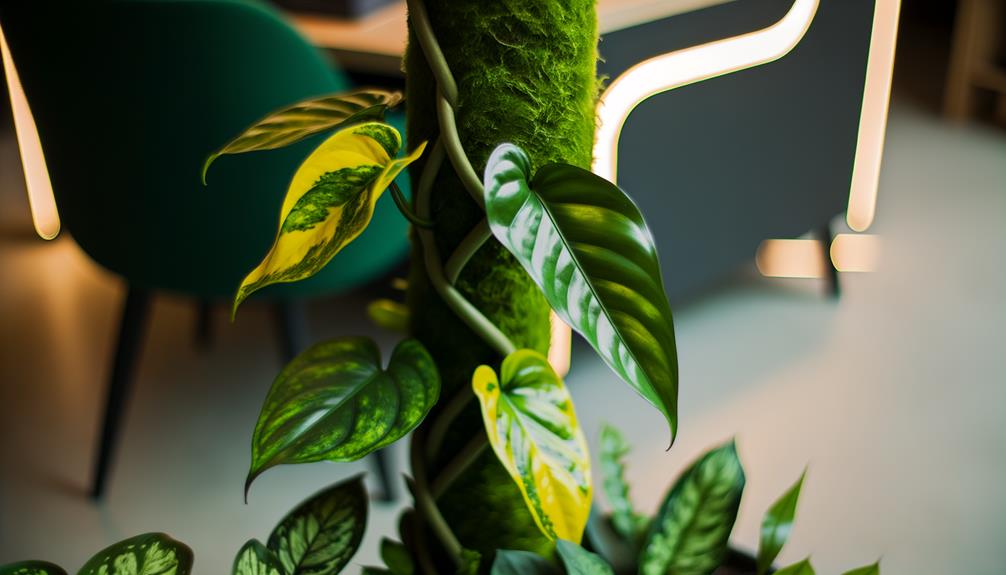
Key Takeaways
- A Philodendron Brasil Totem is a climbing plant with variegated green and yellow heart-shaped leaves.
- It is a cultivar of the Philodendron hederaceum species, originating from Central and South American rainforests.
- The plant thrives in high humidity, indirect sunlight, and requires well-draining soil.
- It uses aerial roots to climb, making it suitable for moss poles or trellises.
- Regular pruning is necessary to maintain its structure and encourage new growth.
Origin and Background
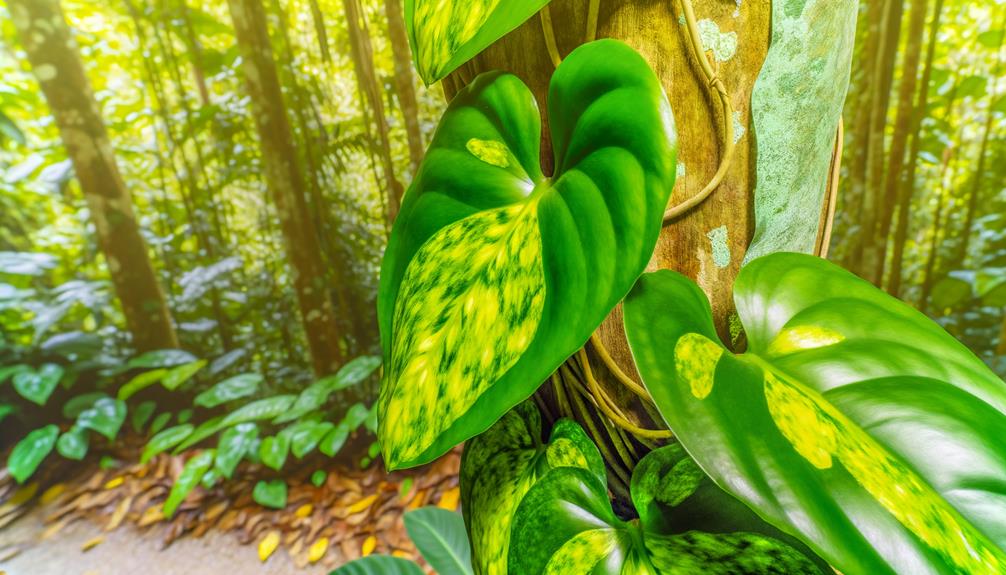
The Philodendron Brasil Totem, a cultivar of the Philodendron hederaceum species, originates from the tropical rainforests of Central and South America, where it thrives in the understory environment. This region's high humidity and consistent temperatures provide ideal conditions for the plant's growth.
Adapted to low-light conditions, it exhibits a remarkable ability to photosynthesize efficiently under the canopy of larger trees. The species is part of the Araceae family, which encompasses a wide variety of aroids known for their ornamental foliage. Indigenous cultures have historically utilized Philodendrons for medicinal purposes.
Today, its robust nature and minimal care requirements make it a popular choice for indoor horticulture, particularly in temperate regions where recreating its natural habitat is feasible.
Appearance and Features
The Philodendron Brasil Totem exhibits distinctive variegated foliage characterized by striking green and yellow patterns, contributing to its ornamental appeal.
This species demonstrates a vigorous climbing growth habit, making it well-suited for vertical structures and indoor environments.
Best growth conditions include moderate humidity levels, indirect sunlight, and well-draining soil.
Leaf Color and Patterns
Philodendron Brasil Totem exhibits striking variegation with its leaves displaying a vibrant mix of emerald green and lemon-yellow patterns. This variegation occurs due to the differential expression of chlorophyll and other pigments within the leaf tissue.
The emerald green regions are rich in chlorophyll, facilitating efficient photosynthesis, whereas the lemon-yellow sectors contain reduced chlorophyll, contributing to the plant's ornamental appeal.
Leaves are typically heart-shaped, with smooth, glossy surfaces that enhance their visual allure. The variegated pattern is not uniformly distributed, resulting in each leaf having a unique aesthetic.
This chromatic diversity not only augments the plant's decorative value but also reflects its genetic heterogeneity. Such variegation is a sought-after trait among horticulturists and plant enthusiasts alike.
Climbing Growth Habit
In addition to its vibrant variegation, Philodendron Brasil Totem demonstrates a robust climbing growth habit, characterized by its aerial roots and vining stems that readily attach to supports. This climbing behavior results from specialized structures called adventitious roots, which emerge along the stem nodes. These roots allow the plant to anchor itself efficiently to vertical surfaces, facilitating upward growth.
The stems elongate, producing new leaves at each node, which enhances the plant's aesthetic appeal. Moreover, the vining nature of Philodendron Brasil Totem makes it highly adaptable for use with moss poles or trellises, which provide the necessary support for best growth. This climbing tendency not only maximizes spatial utilization but also contributes to its overall structural elegance.
Suitable Environment Conditions
Best growth for Philodendron Brasil Totem frequently requires a warm, humid environment with indirect light, which mimics its native tropical habitats. Ideal temperatures range between 65-80°F (18-27°C), while humidity levels should remain above 60%.
Inadequate humidity may result in leaf browning or curling. Indirect light is essential; direct sunlight can scorch the variegated leaves, while insufficient light may cause leggy growth and diminished variegation.
Soil should be well-draining yet retain moisture, typically achieved with a mix of peat, perlite, and pine bark. Regular misting or a humidity tray can maintain necessary moisture levels.
Additionally, indoor air circulation should be optimized to prevent fungal infestations, promoting healthy growth and vibrant foliar development.
Light Requirements
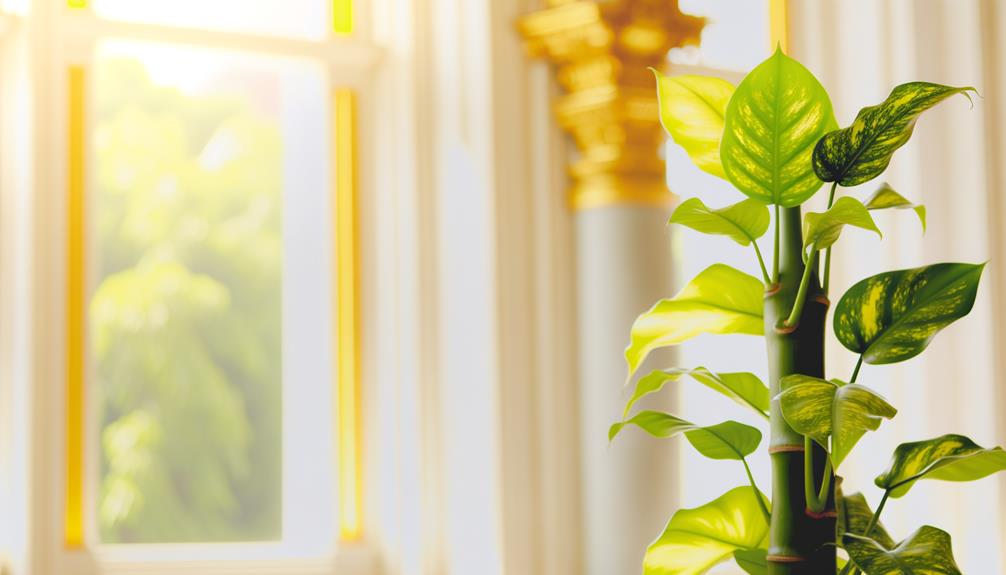
Perfect light conditions are necessary for the thriving growth of the Philodendron Brasil Totem. This plant requires bright, indirect light to maintain its vibrant variegation and overall health. Direct sunlight should be avoided, as it can cause leaf scorching and chlorosis.
Conversely, low light conditions may lead to reduced variegation and leggy growth patterns. Best placement includes east or north-facing windows where filtered light is abundant. Artificial grow lights can supplement natural light, especially in dim environments, ensuring a consistent photosynthetic process.
It is important to monitor light exposure to prevent etiolation, characterized by elongated stems and pale leaves, which compromises the plant's structural integrity and aesthetic appeal.
Watering Needs
The Philodendron Brasil Totem requires a specific watering schedule to maintain peak health. Typically, it needs hydration when the top 1-2 inches of soil become dry.
It is essential to monitor for signs of overwatering, such as yellowing leaves and root rot. These issues can significantly impact the plant's vigor.
Proper water management guarantees vigorous growth and prevents common water-related issues.
Optimal Watering Schedule
Determining the best watering schedule for Philodendron Brasil Totem involves understanding its natural habitat and soil moisture preferences, which are crucial for maintaining its health and vigor. Originating from tropical rainforests, this plant thrives in environments with consistent humidity and well-draining soil. Proper watering practices are vital to replicate these conditions in a domestic setting.
- Frequency: Water about once a week, allowing the top inch of soil to dry out between waterings.
- Water Quality: Use room-temperature, filtered or distilled water to avoid harmful chemicals.
- Seasonal Adjustments: Increase watering during the growing season (spring and summer) and decrease during dormancy (fall and winter).
- Humidity: Maintain ambient humidity levels around 60-70%.
- Drainage: Make sure pots have adequate drainage to prevent waterlogging.
Signs of Overwatering
Excessive watering of Philodendron Brasil Totem can lead to root rot, manifesting through symptoms such as yellowing leaves, wilting, and a soggy substrate. Yellowing leaves often result from impaired oxygen exchange due to waterlogged roots.
Wilting, despite adequate water, indicates compromised root function and potential fungal infection. The substrate should ideally be slightly moist, not water-saturated; persistent sogginess is a critical sign of overwatering.
Additional symptoms include mushy roots, a foul odor emanating from the soil, and slowed growth due to poor nutrient uptake. To mitigate overwatering, ensure adequate drainage and allow the topsoil to dry between watering sessions.
Monitoring environmental conditions and adjusting watering frequency accordingly is essential for maintaining plant health.
Soil and Potting
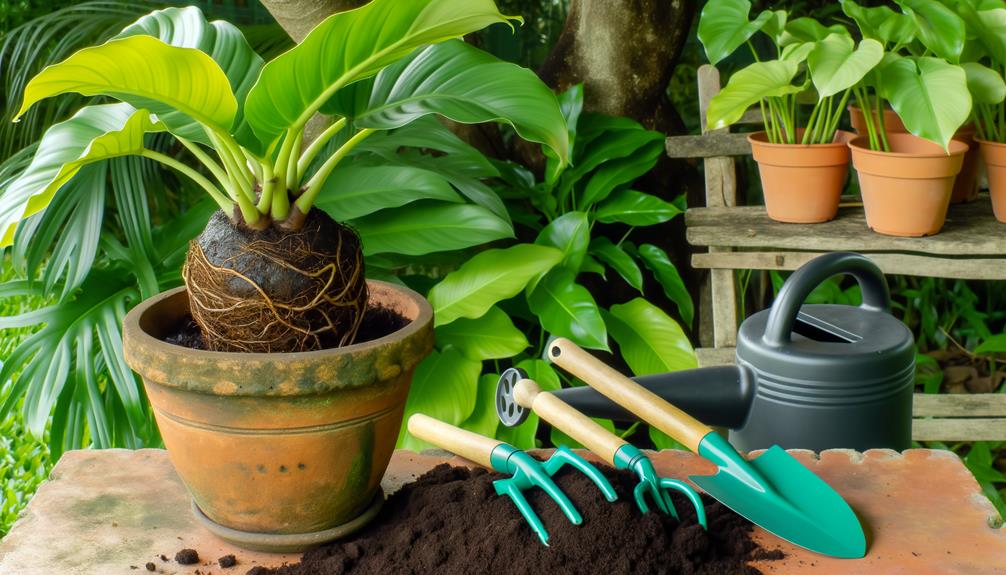
Best growth of the Philodendron Brasil Totem necessitates a well-draining potting mix enriched with organic matter to guarantee sufficient aeration and moisture retention. The ideal soil composition should include components that facilitate root development while preventing waterlogging, which can lead to root rot. A balanced mix may consist of peat moss, perlite, and orchid bark.
To maintain the perfect environment:
- Peat Moss: Boosts moisture retention while providing essential nutrients.
- Perlite: Enhances aeration and drainage, preventing soil compaction.
- Orchid Bark: Adds structure, promoting air circulation around roots.
- Charcoal: Absorbs impurities and aids in drainage.
- Compost: Contributes additional organic nutrients, supporting vigorous growth.
Proper potting practices will significantly impact the overall health and strength of the Philodendron Brasil Totem.
Pruning and Maintenance
Regular trimming is important to maintain the structural integrity and aesthetic appeal of the Philodendron Brasil Totem. Trimming involves the selective removal of superfluous or unhealthy plant material to promote robust growth and an orderly appearance.
Utilize sterilized, sharp trimming shears to remove leggy stems and yellowing leaves at their base. This practice not only optimizes light penetration and air circulation but also stimulates the emergence of new shoots.
Additionally, periodically inspecting and cleaning the totem support structure prevents the accumulation of debris and pests. It is advisable to perform trimming during the plant's active growing season, typically in spring and summer, to guarantee maximum recovery and growth efficiency.
Regular maintenance fosters a lush, vibrant Philodendron Brasil Totem.
Common Problems and Solutions
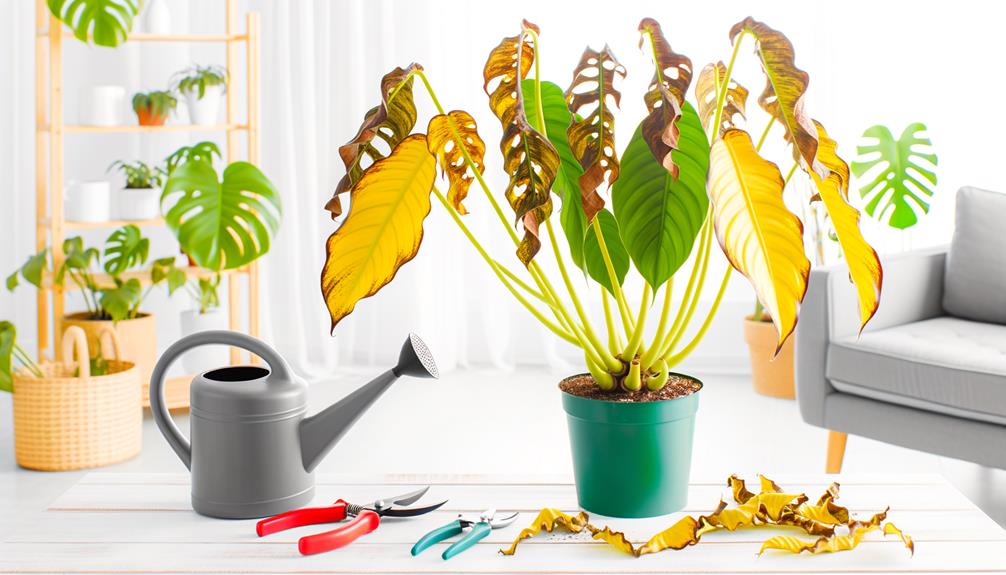
Philodendron Brasil Totem, like many indoor plants, can encounter various issues such as pest infestations, fungal diseases, and nutrient deficiencies, each requiring specific diagnostic and remedial measures. Effective management of these problems involves recognizing symptoms and implementing appropriate treatments.
- Pest Infestations: Aphids and mealybugs can be controlled using insecticidal soap or neem oil.
- Fungal Diseases: Root rot, caused by overwatering, can be mitigated by ensuring well-draining soil and reducing watering frequency.
- Nutrient Deficiencies: Yellowing leaves may indicate a lack of nitrogen, remedied by applying a balanced liquid fertilizer.
- Leaf Spotting: Fungal leaf spots can be treated with a fungicide and by improving air circulation.
- Environmental Stress: Browning leaf edges often result from low humidity, which can be alleviated by using a humidifier.
Conclusion
To sum up, the Philodendron Brasil Totem exemplifies the adage, 'A stitch in time saves nine,' through its meticulous care requirements. Originating from tropical regions, this plant demands specific light, water, soil, and pruning conditions for best growth. Understanding its distinctive appearance, features, and common issues guarantees robust health.
By adhering to these detailed guidelines, the Philodendron Brasil Totem will thrive, offering both aesthetic and ecological benefits within indoor environments.


